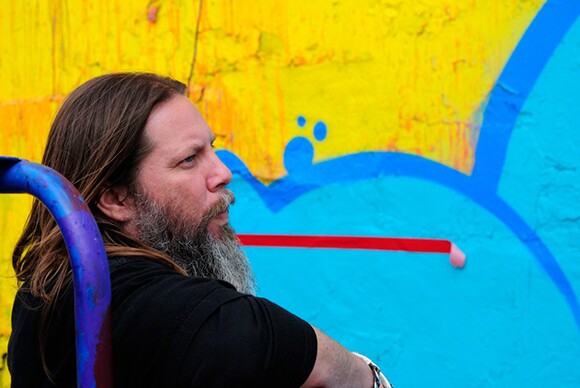Street Artist RISK Transforms Skid Row with Murals

In Partnership with Skid Row Freewalls Project, a collaboration between the Skid Row Housing Trust and LALA Arts, is a large-scale public art mural project dedicated to infusing life and hope into a community of residents, workers, and commuters in the Skid Row area.
On the border of the Arts District, on a wall facing Skid Row, "Ye Sun" fills the side of the Hotel Las Americas with rays designed to symbolize the energy, struggles, hopes and dreams of the residents. It's a mural by RISK, another project managed by Daniel Lahoda of LA Freewalls, who were approached by Skid Row Housing Trust to bring art to their world.
When asked about the mural by RISK, Lahoda checked-in while still on the fringe of Miami, at Art Basel, where the LA Freeways curator was winding down almost ten days of working with RISK and others to produce murals in Park West, the underdeveloped neighborhood on the fringe of a different Downtown.
"This is part of a larger [downtown Los Angeles] mural project that I'll be developing with Skid Row Housing Trust to beautify their buildings." Lahoda said.
"I've been talking with them about doing murals for the past few months. After discussing about a number of artists and the overall strategy of the project, the Trust decided to ask RISK if he would like to participate as the first artist," he said, adding RISK's has a personal conviction to push forward that neighborhood's development. "This was a great way for us to help him realize his goals."

When Lahoda was introduced to Skid Row Housing Trust, and the way they look for ways enhance the neighborhoods they serve, he reasoned collaborating with them was a way to make give the new wave of downtown Los Angeles mural a wider footprint.
"This is the start of a larger project that we are doing with the Housing Trust to beautify their properties," he says.
When Lahoda told MOCA's Ethel Seno about the project, she spoke to her colleagues, prompting the museum to approach Lahoda to ask if they could help with the documentation of RISK's mural. "It's great to have an institution like MOCA help us document this neighborhood development. It shows they're totally down for the community and Public Art in L.A."


"The building has been transformed with this mural. Not only aesthetically on the outside, but the residents are brighter and happier," said Lahoda. "I witnessed a grand transformation in the way they talked, walked, and carry themselves. The way they think about their place in a world that has shifted."
It also rides on MOCA's "Art In The Streets," a survey on East and West Coast influences that ran for 81 days and broke previous daily attendance records, according to a release from an August 11 statement. The final week of the show drew 32,278 visitors, also a MOCA record.
Completing the piece took over five days, off and on, and came after two meetings with residents of the building, who simply wanted with "bright high energy, and uplifting," Lahoda said. RISK met with residents during the second meeting, with a few ideas.
RISK, born Kelly Graval, added the name of every resident on the mural titled "Ye Sun," designed as sun rays that symbolize energy, their struggles, hopes and dreams.

RISK has seen those struggles for a bulk of his life. He spent time in these very streets, running around and "developing artistic skills." Which, for a graffiti artist, means getting his name out and seen. "I used to have wall stuff for years, in the 80s," he said, then adding that when his name was known in the streets, and saw how people reacted, he asked himself. "Well, here we are. People are listening. What you have to say?"
It was a good question.
After looking at his process and asking himself why, he worked toward less self-promotion, but connection with urban landscape with emotion, but without letters and imagery. Out from it comes an abstraction of color, covering over urban forms, be it walls or fire hydrants. It's stripped down to abstractions of saturated hot reds, oranges, yellows washed, sometimes accented with cooler shades of blue and greens. The only names on it are RISK, and the residents of the hotel. It's a personal art movement he calls "Beautifully Destroyed."
In a series of photos and a video by MOCA documenting the work, shot in tandem by Todd Mazer and Birdman, RISK's mural can be seen from the air.


What you won't see from the sky or the street is a smaller 20-foot by 20-foot piece in the courtyard of the Skid Row Trust Housing. That's just something between the residents and RISK, who are finding their place in the world by way of the streets of downtown Los Angeles.

Dig this story? Sign up for our newsletter to get unique arts & culture stories and videos from across Southern California in your inbox. Also, follow Artbound on Facebook and Twitter.


